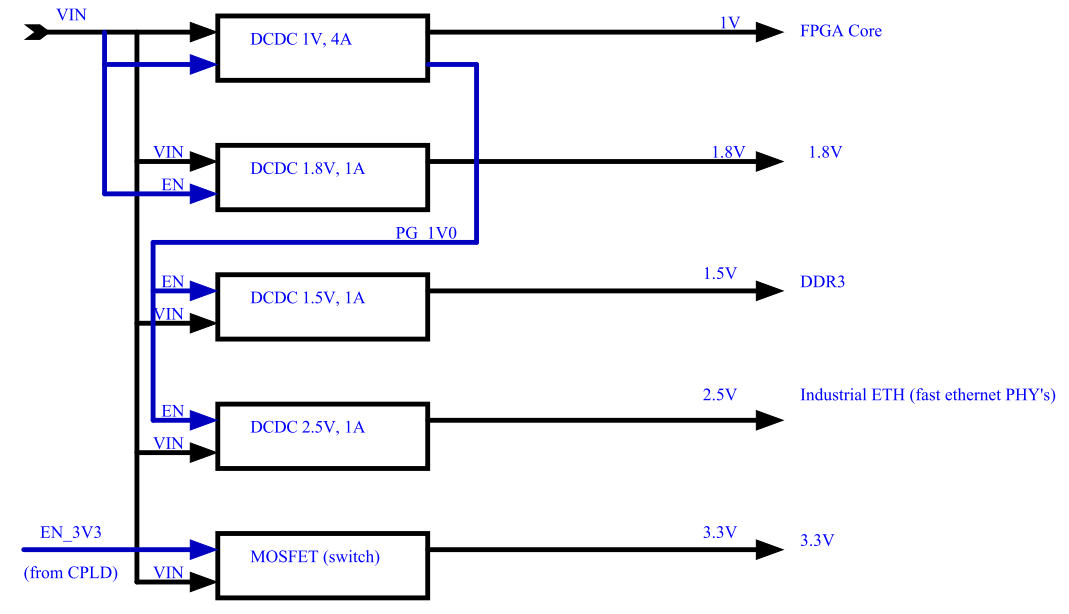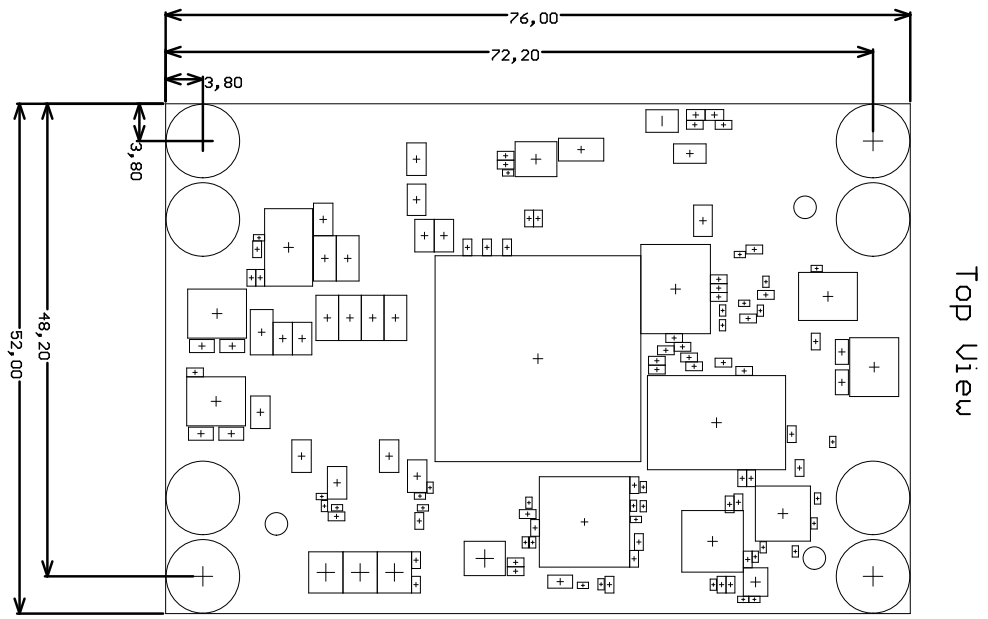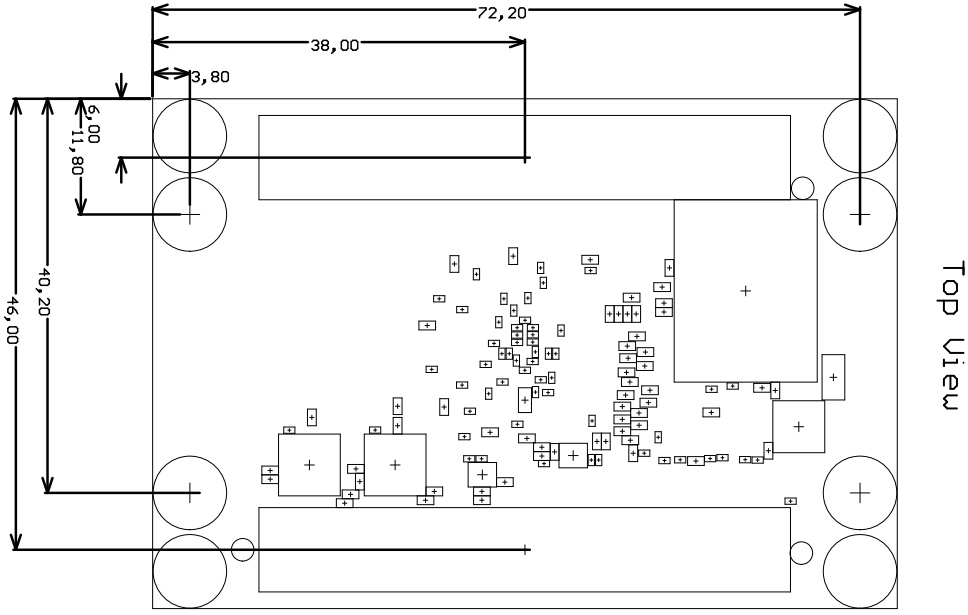Page History
...
- Industrial-grade Xilinx Zynq-7000 (XC7Z020) SoM
- Rugged for shock and high vibration
- 2 x ARM Cortex-A9
- 1 x 10/100/1000 Mbps Ethernet transceiver PHY
- 2 x 10/100 Mbps Ethernet transceiver PHYsPHY's
- 3 x MAC-Address EEPROMsEEPROM's
- 16-Bit wide 512 MByte DDR3 SDRAM
- 32 MByte QSPI - Flash -Memorymemory
- 4 GByte e-NAND - Flash -Memory memory (embedded eMMC Memory)
- USB 2.0 high-speed ULPI transceiver
- Plug-on module with two 120-pin connectors
- Evenly-spread supply pins for good signal integrity
- 136 FPGA I/Os (58 LVDS pairs possible)
- 8 PS MIO pins
- On-board high-efficiency DC-DC converters
- 4.0 A x 1.0 V power rail
- 1.5 A x 1.5 V power rail
- 1.5 A x 1.8 V power rail
- 1.5 A x 2.5 V power rail
- System management
- eFUSE bit-stream encryption
- AES bit-stream encryption
- Temperature compensated RTC (real-time clock)
- User LED
...
Special purpose pins used by TE0729
| Name | Note |
|---|---|
| NRST | Reset-Signal from Watchdog, available at B2B J2-89 |
| NRST_IN | External Reset, available at B2B J2-91 |
Boot Modes
TE0729 supports primary boot from
...
The boot modes are controlled by the Pins 'BOOT1' and 'BOOT2' on the board to board (B2B) connector.
BOOTMODE1 (M2) | BOOTMODE2 (M0) | M1 | M3 | Boot mode |
|---|---|---|---|---|
| LOW | LOW | LOW | LOW | JTAG |
| LOW | HIGH | LOW | LOW | SPI (also eMMC as secondary boot) |
| HIGH | LOW | LOW | LOW | illegal |
| HIGH | HIGH | LOW | LOW | SD Card |
JTAG
JTAG access to the Xilinx Zynq-7000 device is provided by connector J2.
| Signal | B2B Pin |
|---|---|
| TCK | J2: |
| 119 | |
| TDI | J2: |
| 115 | |
| TDO | J2: |
| 117 | |
| TMS | J2: |
| 113 |
| Note |
|---|
JTAGSEL pin in J2 should be kept low or grounded for normal operation. |
Clocking
| Clock | Frequency | IC | FPGA | Notes |
|---|---|---|---|---|
| PS CLK | 33.3333 MHz | U14 | PS_CLK | PS Subsystem main clock |
| 10/100/1000 Mbps ETH PHY reference | 25 MHz | U10 | - | |
| USB PHY reference | 52 MHz | U12 | - |
Processing System (PS) Peripherals
| Peripheral | IC | Designator | PS | MIO | Notes |
|---|---|---|---|---|---|
| EEPROM I2C | 24AA025E48T-I/OT | U8 | I2C0 | MIO10, MIO11 | MAC Address |
| EEPROM I2C | 24AA025E48T-I/OT | U9 | I2C0 | MIO10, MIO11 | MAC Address |
| EEPROM I2C | 24AA025E48T-I/OT | U20 | I2C0 | MIO10, MIO11 | MAC Address |
| RTC | ISL12020MIRZ | U22 | I2C0 | MIO10, MIO11 | Temperature compensated real time clock |
| RTC Interrupt | ISL12020MIRZ | U22 | GPIO | MIO46 | Real Time Clock Interrupt |
| SPI Flash | S25FL256SAGBHI20 | U13 | QSPI0 | MIO1..MIO6 | |
| Ethernet0 10/100/1000 Mbps PHY | 88E1512-A0-NNP2I000 | U3 | ETH0 | MIO16...MIO27 | |
| Ethernet0 10/100/1000 Mbps PHY Reset | GPIO | MIO51 | |||
| Ethernet1 10/100 Mbps PHY | KSZ8081MLXCA | U17 | - | (EMIO) | |
| Ethernet1 10/100 Mbps PHY Reset | - | (EMIO) | |||
| Ethernet2 10/100 Mbps PHY | KSZ8081MLXCA | U19 | - | (EMIO) | |
| Ethernet2 10/100 Mbps PHY Reset | - | (EMIO) | |||
| USB | USB3320C-EZK | U11 | USB0 | MIO28...MIO39 | |
| USB Reset | GPIO | MIO49 | |||
| e-MMC (embedded e-MMC) | MTFC4GMVEA-4M IT | U5 | SDIO0 | MIO40...MIO45 |
Default MIO mapping
| MIO | Configured as | B2B | Notes |
|---|---|---|---|
| 0 | GPIO | J2-87 | B2B |
| 1 | QSPI0 | - | SPI Flash-CS |
| 2 | QSPI0 | - | SPI Flash-DQ0 |
| 3 | QSPI0 | - | SPI Flash-DQ1 |
| 4 | QSPI0 | - | SPI Flash-DQ2 |
| 5 | QSPI0 | - | SPI Flash-DQ3 |
| 6 | QSPI0 | - | SPI Flash-SCK |
| 7 | GPIO | - | Red LED D8 |
| 8 | - | - | QSPI feedback clock |
| 9 | GPIO | J2-88 | B2B |
| 10 | I2C0 SDA | J2-90 | B2B |
| 11 | I2C0 SCL | J2-92 | B2B |
| 12 | I2C1 SDA | J2-93 | B2B (SDA on-board I2C, also configurable as GPIO by user) |
| 13 | I2C1 SCL | J2-95 | B2B (SCL on-board I2C, also configurable as GPIO by user) |
| 14 | USART0 RX | J2-94 | B2B (RX on-board UART, also configurable as GPIO by user) |
| 15 | USART0 TX | J2-96 | B2B (TX on-board UART, also configurable as GPIO by user) |
| 16..27 | ETH0 | Ethernet RGMII PHY | |
| 28..39 | USB0 | USB ULPI PHY | |
| 40 | SDIO0 | J2-100 | |
| 41 | SDIO0 | J2-102 | |
| 42 | SDIO0 | J2-104 | |
| 43 | SDIO0 | J2-106 | |
| 44 | SDIO0 | J2-108 | |
| 45 | SDIO0 | J2-110 | |
| 46 | GPIO | - | RTC Interrupt |
| 47 | - | - | - |
| 48 | GPIO | SEL_SD | SD Card multiplexer control |
| 49 | GPIO | - | USB Reset |
| 50 | GPIO | - | ETH0 Interrupt |
| 51 | GPIO | - | ETH0 Reset |
| 52 | ETH0 | - | MDC |
53 | ETH0 | - | MDIO |
I2C Interface
The on-board I2C components are connected to MIO10 and MIO11 and configured as I2C0 by default.
I2C addresses for on-board components
| Device | I2C-Address | Notes |
|---|---|---|
| EEPROM for MAC1 | 0x50 | |
| EEPROM for MAC2 | 0x51 | |
| EEPROM for MAC3 | 0x52 | |
| RTC | 0x6F | |
| Battery backed RAM | 0x57 | integrated in RTC |
B2B I/O
Number of I/O's connected to the SoC's I/O bank and B2B connector
| Bank | Type | B2B | IO count | IO Voltage | Notes |
|---|---|---|---|---|---|
| 500 | MIO | J2-87 J2-88 | 2 | 3,3 V | MIO0, MIO9 |
| 500 | MIO | J2-93 J2-95 J2-94 J2-96 | 4 | 3,3 V | configured as I2C1 and USART0 by default, configurable as GPIO by user |
| 13 | HR | J1 | 48 | user | |
| 33 | HR | J1 | 48 | user | |
| 35 | HR | J2 | 30 | 3,3 V | |
| 34 | GPIO | J2 | 10 | 2,5 V | configured as DISP_RX by default, configurable as GPIO by user |
For detailed information about the pin out, please refer to the Master Pinout Pin-out Table.
Peripherals
LED's
There are 3 LED's on TE0729:
| LED | Color | Connected to | Notes |
|---|---|---|---|
| D1 | red | System Controller | Global Status LED |
| D2 | green | DONE | Inverted DONE, ON when FPGA not configured |
| D8 | red | MIO7 | OFF when PS7 not booted and not controlling MIO7 by software, else user controlled |
| Note |
|---|
LED D2 is connected to the FPGA Done pin and will go off as soon as PL is configured. This LED will not operate if the System Controller can not power on the 3.3V output rail that also powers the 3.3V circuitry on the module. |
...
Ethernet0 PHY connection:
| PHY PIN | ZYNQ PS | Notes |
|---|---|---|
| MDC/MDIO | MIO52, MIO53 | - |
| LED0 | - | pin J2-57 on B2B connector |
| LED1 | - | pin J2-59 on B2B connector |
| LED2/Interrupt | MIO46 | - |
| CONFIG | - | Connected to GND, PHY Address 0 |
| RESETn | MIO51 | - |
| RGMII | MIO16..MIO27 | - |
| SGMII | - | B2B J2 |
| MDI | - | B2B J2 |
The TE0729 SoM is also equipped with two additional Microchip KSZ8081MLXCA Ethernet -PHYs (ICs PHY's (IC's U17 and U19) to provide further 10/100 Mbps Ethernet interfaces with the identifiers Ethernet1 and Ethernet2. The reference clock input of both PHYs is supplied from the same 25MHz oscillator (U10), which also provides Ethernet0 Gigabit PHY with a reference clock signal.
Ethernet1 PHY connection to B2B-connectors:
| PHY PIN | B2B | notes |
|---|---|---|
| ETH1_RX_P | J2-26 | - |
| ETH1_RX_N | J2-28 | - |
| ETH1_TX_P | J2-20 | - |
| ETH1_TX_N | J2-22 | - |
| ETH1_LED0 | J2-34 | Status LED |
| ETH1_LED1 | J2-32 | Transmission LED |
Ethernet2 PHY connection to B2B-connectors:
| PHY PIN | B2B | notes |
|---|---|---|
| ETH2_RX_P | J2-2 | - |
| ETH2_RX_N | J2-4 | - |
| ETH2_TX_P | J2-8 | - |
| ETH2_TX_N | J2-10 | - |
| ETH2_LED0 | J2-16 | Status LED |
| ETH2_LED1 | J2-14 | Transmission LED |
All other pins of the PHYs are connected to Bank34 of Zynq, see schematic for further details.
...
The reference clock input of the PHY is supplied from an on board 52MHz oscillator (U12).
PHY connection:
| PHY Pin | Zynq Pin | B2B Name | Notes |
|---|---|---|---|
| ULPI | MIO28..39 | - | Zynq USB0 MIO pins are connected to the PHY |
| REFCLK | - | - | 52MHz from on board oscillator (U12) |
| REFSEL[0..2] | - | - | 000 GND, select 52MHz reference Clock |
| RESETB | MIO49 | - | Active low reset |
| CLKOUT | MIO36 | - | Connected to 1.8V selects reference clock operation mode |
| DP,DM | - | OTG_D_P, OTG_D_N | USB Data lines |
| CPEN | - | VBUS_V_EN | External USB power switch active high enable signal |
| VBUS | - | USB_VBUS | Connect to USB VBUS via a series resistor. Check reference schematic |
| ID | - | OTG_ID | For an A-Device connect to ground, for a B-Device left floating |
The schematic for the USB connector and required components is different depending on the USB usage. USB standard A or B connectors can be used for Host or Device modes. A Mini USB connector can be used for USB Device mode. A USB Micro connector can be used for Device mode, OTG Mode or Host Mode.
...
This RTC IC is supported in Linux so it can be used as hwclock device.
MAC-Address
...
EEPROM's
Three Microchip 24AA025E48 EEPROMs EEPROM's (U8, U9, U20) are used on the TE0729. They contain globally unique 48-bit node addresses, that are compatible with EUI-48(TM) and EUI-64(TM). The devices are organized as two blocks of 128 x 8-bit memory. One of those blocks stores the 48-bit node address and is write protected, the other block is available for application use. It is accessible through the I2C slave address 0x50 for MAC-Address1 (U8), 0x51 for MAC-Address2 (U9), 0x52 for MAC-Address3 (U20).
...
VIN and 3.3VIN can be connected to the same source (3.3 V).
Power Supplies
Supply Voltage | Voltage Range | Note |
|---|
VIN | 3.3 V to 5.5 V |
|
| VIN 3.3V | 3.3 V |
|
Bank Voltages
| Bank | Voltage | max. Value | note |
|---|---|---|---|
| 501 | 1,8 V | - | ETH0 / USB0 / SDIO0 |
| 500 | 3,3 V | - | SPI / I2C / UART |
| 502 | 1,5 V | - | DDR3-RAM |
| 13 | user | 3,3 V | connected to 3,3V by default by 0-Ohm-Resistor R36 |
| 33 | user | 3,3 V | connected to 3,3V by default by 0-Ohm-Resistor R55 |
| 34 | 2,5 V | - | ETH / DISP |
| 35 | 3,3 V | - | GPIO |
Initial Delivery state
Power-up sequence at start-up
The Trenz TE0729 is equipped with several DC-DC-voltage-regulators to generate the required on-board voltages with the values 1V (FPGA core), 1.8 V (VCC0 MIO, VCCAUX, AVCC, VCCPLL, VDD USB and ETH PHYs), 1.5V (DDR3), 2.5V (Industrial fast ETH-PHY's) and 3.3V (VCCIO, pheripheral components).
In the first step at device start-up the voltages 1V and 1.8V are generated for the FPGA core and programmable logic banks. The voltages 1.5V and 2.5 V are enabled after the voltage 1V has stabilized. The voltage 3.3V is enabled by the CPLD system controller at last.
The voltage 3.3V is available on B2B-connector at pins J1-65, J1-66 and an indicator for stabilized on-board voltages in steady state.
| Warning |
|---|
| To avoid any damages to the SoM, check the 3.3V voltage before powering up the SoC's I/O bank voltages VCCIO_13 and VCCIO_33. |
Pay attention to the voltage level of the I/O-signals, which must not be higher then VCCIO+0.4V.
Initial Delivery state
| Storage device |
|---|
| name | Content | Notes |
|---|---|---|
24AA025E48 |
EEPROM's | User content not programmed | Valid MAC Address from manufacturer |
| e-MMC Flash-Memory | Empty, not programmed | Except serial number programmed by flash vendor |
SPI Flash OTP Area | Empty, not programmed | Except serial number programmed by flash vendor |
SPI Flash Quad Enable bit | Programmed | |
SPI Flash main array | demo design | |
EFUSE USER | Not programmed | |
EFUSE Security | Not programmed |
Hardware Revision History
| Revision | Changes |
|---|---|
01 | Prototypes |
| 02 | First production release |
Technical Specification
Absolute Maximum Ratings
| Parameter | Min | Max | Units | Notes |
|---|---|---|---|---|
Vin supply voltage | -0.1 | 3.75 | V |
| VBAT supply voltage | -0.3 | 6.0 | V | |
| PL IO Bank supply voltage for HR I/O banks (VCCO) | -0.5 | 3.6 | V | |
| I/O input voltage for HP I/O banks | -0.55 | VCCO_X+0.55 | V | TE0729 does not have HP banks |
Voltage on Module JTAG pins | -0.4 | VCCO_0+0.55 | V | VCCO_0 is 3.3V nominal |
Storage Temperature | -40 | +85 | C | |
| Storage Temperature without the ISL12020MIRZ | -55 | +100 | C |
| Note |
|---|
| Assembly variants for higher storage temperature range on request |
...
Recommended Operating Conditions
| Parameter | Min | Max | Units | Notes | Reference document |
|---|---|---|---|---|---|
| Vin supply voltage | 2.5 | 3.6 | V |
| VBAT supply voltage | 1.8 | 5.5 | V | ||
| PL IO Bank supply voltage for HR I/O banks (VCCO) | 1.14 | 3.465 | V | Xilinx document DS191 | |
| I/O input voltage for HR I/O banks | (*) | (*) | V | (*) Check datasheet | Xilinx document DS191 and DS187 |
| Voltage on Module JTAG pins | 3.135 | 3.465 | V | VCCO_0 is 3.3 V nominal |
Physical Dimensions
Please download the assembly diagram for exact values.
...
All dimensions are shown in mm.
Weight | Part |
|---|---|
21,6 g | Plain module |
Temperature Ranges
Commercial grade modules
...
All parts are at least industrial temperature range of -40°C to +85°C. The module operating temperature range depends on customer design and cooling solution. Please contact us for options.
Document Change History
| date | revision | authors | description |
|---|---|---|---|
| 2016-06-14 | v10 | initial release |
Disclaimer
| Include Page | ||
|---|---|---|
|
...
|
...
|


